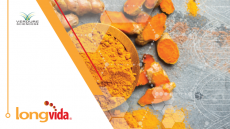Nutrition shake with EPA and BCAA shows muscle mass and strength benefits in elderly

Older populations are at risk of sarcopenia (an age-related loss of skeletal muscle mass, and strength). Previous evidence suggests that the mechanism of sarcopenia involves systemic inflammation leading to increased degradation of protein and lipid from muscle and adipose tissue storage.
Previous studies reveal that inadequate protein intake is associated with low muscle mass index in elderly people and demonstrate the potential benefit of eicosapentaenoic acid (EPA).
What's more, a previous study showed that a single dose of amino acid-rich complete nutrition drinks could stimulate the rate of muscle synthesis. The effect may be due to branched-chain amino acids (BCAAs) especially leucine which is critical protein synthesis for muscle.
Leucine was shown to be the primary stimulator of muscle protein synthesis via the mammalian target of the rapamycin complex 1 (mTORC1) pathway. Therefore, the elevation of plasma leucine concentration by providing leucine-enriched nutrition supplements with an adequate energy drink can resume muscle protein synthesis.
Nevertheless, it is still unclear if a combination between EPA and BCAA would be effective in improving muscle health and reducing the risk of sarcopenia in the elderly at risk.
The current study, conducted in Thailand, therefore aimed to investigate the effect of energy supplementation and the combination of anti-inflammatory factor (eicosapentaenoic acid; EPA) and muscle-synthesis substrate (branched-chain amino acids; BCAA) on body composition, muscle degradation, and inflammatory biomarkers in elderly people with inadequate protein intake.
The study
A randomised blinded placebo-controlled trial was conducted on 84 elderly with inadequate protein intake. The participants were randomly assigned into four groups receiving a complete nutrition drink; (1) control formula, (2) fortified with 2.2 g EPA, (3) with 2.2 g EPA and 5 g BCAA (2:1:1 of Leu: Ile: Val), and (4) with 2.2 g EPA plus 5g BCAA (4:1:1 of Leu: Ile: Val).
Each subject consumed two sachets of the drink to gain 500 kcal/day and performed arm muscle exercises for 3 weeks. Body compositions and handgrip strength were measured using BIA and a dynamometer, respectively.
Plasma EPA and BCAA levels were determined using LC-MS/MS to ensure compliance. Muscle protein biomarkers including histidine, β-alanine, and carnosine were measured using LC-MS/MS. Serum inflammatory (IL-6) and anti-inflammatory cytokines (IL-10) were measured by using ELISA.
Resulting data indicate a significant improvement in right arm muscle mass and right handgrip strength in the group receiving a complete nutrition drink fortified with EPA and BCAA 2:1:1 and 4:1:1 of Leu: Ile: Val. However, the changes were not statistically different from those of control or EPA-only formulas.
The plasma metabolite of EPA, leucine, and isoleucine was significantly increased among all interventions within 3 weeks.
No significant changes in inflammatory cytokines and muscle degradation markers were observed. Nevertheless, the tendency of decreased inflammatory cytokines and increased inflammatory cytokines, decreased histidine, and increased carnosine was observed after consuming EPA and BCAA (4:1:1) compared to the placebo control group.
The authors conclude: "This clinical trial suggested that the fortification of EPA together with a high proportion of leucine in BCAA (4:1:1) formula elevated available plasma EPA and BCAA. These findings suggest that consuming a complete nutrition drink fortified with EPA and BCAA 2:1:1 and 4:1:1 for 3 weeks might improve right arm muscle mass and strength likely by the tendency to promote muscle protein synthesis and anti-inflammatory effects. Future studies with longer duration are warranted to confirm it."
Mechanisms of action
A possible mechanism of EPA likely involves anti-inflammation and downregulation of proteasome expression. The anti-inflammatory mechanisms of EPA include protection against the disruption of the cell membrane and inactivation of transcription factor NFκB leading to the suppression of gene transcription for pro-inflammatory cytokines such as IL-1, IL-6, IL-8, and IL-12.
Furthermore, EPA is also an inhibitor of platelet-activating factor (PAF), which is a potent lipid inflammatory mediator negatively affecting whole-body and skeletal muscle protein synthesis.
Moreover, a plasma lipid profile of lower omega 6, which antagonize omega 3, has been associated with reduced PAF biosynthesis and/or increased catabolism. Interestingly, a recent study showed that the supplementation of an amino acid-rich diet after exercise could preserve lean body mass in older persons.
Source: Frontiers in Nutrition
https://doi.org/10.3389/fnut.2023.1164469
Eicosapentaenoic acid and branched-chain amino acids fortified complete nutrition drink improved muscle strength in older individuals with inadequate protein intake
Authors: Khoonin W, Shantavasinkul PC, Santivarangkna C, Praengam K and Trachootham D












